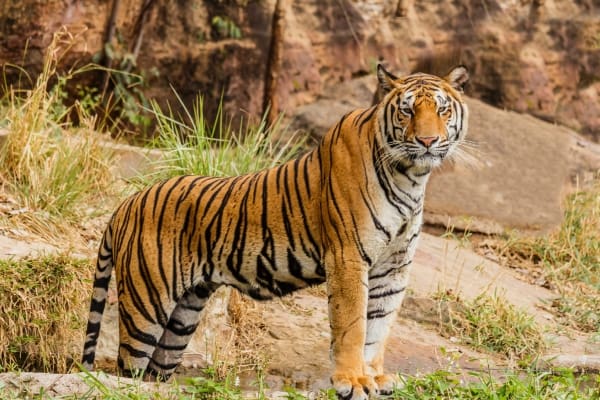
Texas is home to several top-tier zoos that participate in global conservation efforts and house some of the rarest animals on the planet. If you’re visiting zoos in Texas in 2024, you’ll have the opportunity to see some extraordinary species that are critically endangered or rarely seen outside their native habitats. Here’s a list of some rare animals you can see in Texas zoos this year:
1. Attwater’s Prairie Chicken
- Where to See: Houston Zoo (Houston)
- Why It’s Rare: Once abundant on the Texas Gulf Coast, the Attwater’s prairie chicken is now one of the most endangered birds in North America, with fewer than 100 left in the wild. The Houston Zoo has been instrumental in captive breeding and reintroduction efforts to save this critically endangered bird.
2. Sumatran Tiger
- Where to See: Dallas Zoo (Dallas), Fort Worth Zoo (Fort Worth), San Antonio Zoo (San Antonio)
- Why It’s Rare: Sumatran tigers are critically endangered due to deforestation and poaching in their native Indonesia. There are fewer than 400 left in the wild. Many zoos, including those in Texas, are part of breeding programs aimed at maintaining genetic diversity for this rare big cat.
3. Aye-Aye
- Where to See: Dallas Zoo (Dallas)
- Why It’s Rare: This nocturnal lemur from Madagascar is one of the strangest-looking primates, with a unique long middle finger used to extract insects from trees. Aye-ayes are rare in captivity and critically endangered due to habitat loss and hunting in their native Madagascar.
4. Mexican Wolf
- Where to See: El Paso Zoo (El Paso)
- Why It’s Rare: The Mexican wolf is one of the most endangered subspecies of wolf in the world, with fewer than 200 in the wild. El Paso Zoo is involved in the Species Survival Plan (SSP) to protect and breed these rare wolves for potential reintroduction into their natural habitat.
5. Southern White Rhinoceros
- Where to See: Fossil Rim Wildlife Center (Glen Rose), Fort Worth Zoo (Fort Worth), Houston Zoo (Houston)
- Why It’s Rare: While southern white rhinos are more numerous than their northern relatives, they are still considered near-threatened due to poaching. Fossil Rim Wildlife Center and other Texas zoos have successfully bred white rhinos and work toward their conservation.
6. Addax (White Antelope)
- Where to See: Fossil Rim Wildlife Center (Glen Rose), San Antonio Zoo (San Antonio)
- Why It’s Rare: Native to the Sahara Desert, the addax is critically endangered with only a few dozen left in the wild due to illegal hunting. Fossil Rim and other Texas zoos are leading conservation efforts, with several addax bred in captivity for reintroduction into the wild.
7. Black-Footed Ferret
- Where to See: Fort Worth Zoo (Fort Worth), Fossil Rim Wildlife Center (Glen Rose)
- Why It’s Rare: As one of the most endangered mammals in North America, the black-footed ferret is a rare sight. The Fort Worth Zoo and Fossil Rim Wildlife Center are involved in breeding programs to help restore this species to its native grasslands.
8. Bornean Orangutan
- Where to See: Houston Zoo (Houston), Fort Worth Zoo (Fort Worth)
- Why It’s Rare: Bornean orangutans are critically endangered due to deforestation and the illegal pet trade. These Texas zoos are part of global breeding and conservation efforts to protect one of our closest relatives.
9. African Painted Dog
- Where to See: San Antonio Zoo (San Antonio), Dallas Zoo (Dallas)
- Why It’s Rare: African painted dogs are endangered due to habitat loss and conflicts with humans. These highly social and endangered carnivores are being bred in zoos to maintain a healthy population and support efforts to restore them to the wild.
10. Javan Green Magpie
- Where to See: San Antonio Zoo (San Antonio)
- Why It’s Rare: Native to Indonesia, the Javan green magpie is critically endangered and faces severe threats due to habitat destruction and illegal bird trapping. The San Antonio Zoo participates in the breeding program to help this vibrant bird recover.
11. Pygmy Hippopotamus
- Where to See: Dallas Zoo (Dallas), Houston Zoo (Houston)
- Why It’s Rare: Pygmy hippos are native to the forests and swamps of West Africa and are classified as endangered due to habitat loss. They are much smaller and more elusive than their larger relatives, making their appearance in zoos a rare treat for visitors.
12. Scimitar-Horned Oryx
- Where to See: Fossil Rim Wildlife Center (Glen Rose), San Antonio Zoo (San Antonio)
- Why It’s Rare: Declared extinct in the wild, the scimitar-horned oryx has been the subject of successful breeding and reintroduction efforts, largely driven by Texas zoos and wildlife centers. Fossil Rim is particularly notable for its leadership in this species’ recovery.
13. Baird’s Tapir
- Where to See: Houston Zoo (Houston)
- Why It’s Rare: The Baird’s tapir is an endangered species found in Central and South America. Their populations have been severely affected by deforestation and hunting. The Houston Zoo is one of the few places in North America where you can see this rare and elusive creature.
14. Komodo Dragon
- Where to See: Fort Worth Zoo (Fort Worth), San Antonio Zoo (San Antonio)
- Why It’s Rare: Native to Indonesia, Komodo dragons are the largest lizards on the planet and are classified as vulnerable due to habitat loss and a limited range. Texas zoos provide visitors with a rare chance to see this apex predator up close.
15. Bontebok
- Where to See: Fossil Rim Wildlife Center (Glen Rose)
- Why It’s Rare: Once nearly extinct, the bontebok is a striking antelope species native to South Africa. Fossil Rim Wildlife Center has played a crucial role in breeding these animals, helping to bring their numbers back from the brink of extinction.
Conservation Leadership in Texas Zoos
Texas zoos are not only known for their diversity of animals but also for their active involvement in global conservation efforts. Institutions like the Fossil Rim Wildlife Center and the Houston Zoo are pioneers in species recovery programs, particularly for African wildlife and endangered North American species.
In 2024, these zoos continue to lead the charge in animal conservation, offering visitors a unique chance to see some of the rarest species in the world while contributing to their survival. Many of the animals listed are part of Species Survival Plans (SSPs), a collaborative conservation program among zoos to ensure the long-term survival of threatened species through captive breeding, research, and public education.
Texas zoos offer a rare window into the world of conservation, allowing visitors to encounter critically endangered species like the addax, Mexican wolf, and scimitar-horned oryx. These zoos not only inspire wonder but also raise awareness about the need to protect these rare and magnificent animals for future generations.



